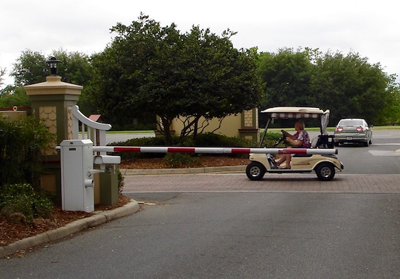The Gated Community, A Model for Urban Mobility Systems?
Gated communities are sometimes view-by both non-residents and residents alike—as a collective of families and individuals separated from the rest of civilization by clear boundaries and a gate (or several gates). Gated communities are also associated with the senior population, despite the fact that young families populate many of them as well. Indeed, to a large extent, this characterization may be accurate.
In addition to the physical and demographic descriptors, gated communities have an air of efficiency about them, as they are noted for the combination of consumer amenities, including restaurants, recreation facilities, theatres, and libraries—and sometimes schools. Moreover, rules and regulations are in place so that residents can easily get from point A to point B—quickly and without traffic delays.
The vehicles used in the transportation network are also key to this environment. They are small and are quick and agile enough to be both fun and efficient. These vehicles are also fuel efficient and essentially non-polluting by conventional automobile and truck standards.
New vehicle developments: New wine in old wineskins?
As previous columns have discussed, there are a plethora of new developments with regard to small vehicles and drive systems. Most, but not all these new vehicle concepts emanate from Europe where there has been intense focus on electrification of the transportation system and the reduction of air-borne pollutants caused by conventional ICE vehicles (consumer and commercial). Europeans are also concerned with urban congestion which result in inordinate delays and is a serious source of pollution as well.
These concerns are also prevalent in the United States and becoming more so, but, compared to Europe, the top-down planning which is required to deal with the situation is far less prevalent. Both in urban environments and in gated communities the introduction of faster, more efficient small vehicles is slow to take hold.
Take for example two vehicles featured in previous columns.
The five-passenger Uniti, developed by a start-up in Sweden. This small electric vehicle has a top speed of 80 m.p.h. and a range of 190 miles on a full charge.
OK, so its not a golf car, but it would be marvelous way to get about the community and jump into the outer world without a hiccup.
The Baro One Golf Car, is a golf car, with many New Age technical features that put it in a different class from your granddad’s golf cart. As an example, this vehicle is designed without a steering wheel. Instead, it is guided by a joystick, which allows human intervention when needed. When needed?! Yes, this vehicle, prototyped in the U.K. comes equipped with Level 3 autonomy—meaning a step just below full driverless capability.
This is the “new wine” that for the moment must be poured into old wineskins. Thus, there will be problems and issues with the typical American consumer used to large conventional vehicles (and F150s) and with the typical gated community resident, I would say, who is enamored with his pride-and-joy golf car.
Embracing the new vehicle class—Gated communities may lead the way
Using the metaphor of the wineskin, we can liken the wineskin to the overall context of the transportation system in the United States. It is that overall system which is slowly evolving to address serious mobility questions found in virtually all major cities and even in the suburbs. Part of the issue relates to the new landscape for many U.S. cities. Urban centers, from which the young of a generation ago fled to find peace and a new lifestyle in the suburbs, are now seeing a pretty amazing rebirth, as today’s youth, the current generation, are returning to take advantage of high tech positions clustered in city center environments.
Still, even this trend seems to be a far cry from the gated community. Yet, I will make the case that when it comes to transportation, there are some remarkably similar requirements that will, I believe result in new wine into new, not old, wineskins.
Unfortunately, I will have to develop this thesis in my next column, due to limited editorial space. So, stay tuned!
Contact the Author: Steve Metzger at smetzger@smallvehicleresource.com. Or check out our website at www.smallvehicleresource.com, where you will find an extensive database of vehicle models and can make side-by-side comparisons of vehicles based on a full set of specifications.


